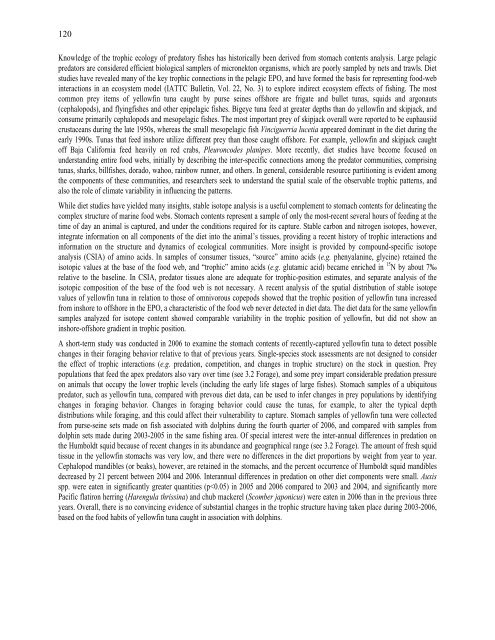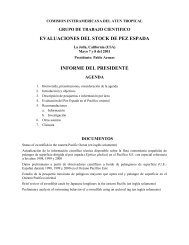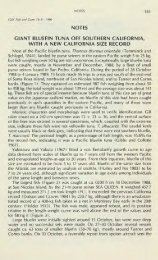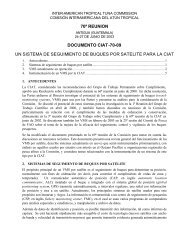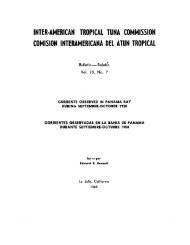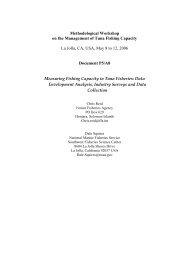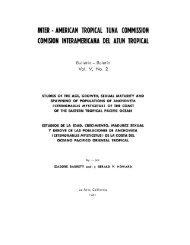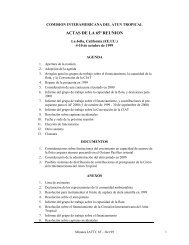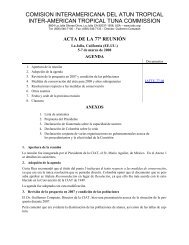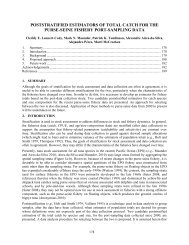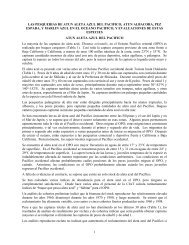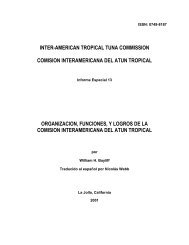INTER-AMERICAN TROPICAL TUNA COMMISSION - Comisión ...
INTER-AMERICAN TROPICAL TUNA COMMISSION - Comisión ...
INTER-AMERICAN TROPICAL TUNA COMMISSION - Comisión ...
- No tags were found...
You also want an ePaper? Increase the reach of your titles
YUMPU automatically turns print PDFs into web optimized ePapers that Google loves.
120Knowledge of the trophic ecology of predatory fishes has historically been derived from stomach contents analysis. Large pelagicpredators are considered efficient biological samplers of micronekton organisms, which are poorly sampled by nets and trawls. Dietstudies have revealed many of the key trophic connections in the pelagic EPO, and have formed the basis for representing food-webinteractions in an ecosystem model (IATTC Bulletin, Vol. 22, No. 3) to explore indirect ecosystem effects of fishing. The mostcommon prey items of yellowfin tuna caught by purse seines offshore are frigate and bullet tunas, squids and argonauts(cephalopods), and flyingfishes and other epipelagic fishes. Bigeye tuna feed at greater depths than do yellowfin and skipjack, andconsume primarily cephalopods and mesopelagic fishes. The most important prey of skipjack overall were reported to be euphausiidcrustaceans during the late 1950s, whereas the small mesopelagic fish Vinciguerria lucetia appeared dominant in the diet during theearly 1990s. Tunas that feed inshore utilize different prey than those caught offshore. For example, yellowfin and skipjack caughtoff Baja California feed heavily on red crabs, Pleuroncodes planipes. More recently, diet studies have become focused onunderstanding entire food webs, initially by describing the inter-specific connections among the predator communities, comprisingtunas, sharks, billfishes, dorado, wahoo, rainbow runner, and others. In general, considerable resource partitioning is evident amongthe components of these communities, and researchers seek to understand the spatial scale of the observable trophic patterns, andalso the role of climate variability in influencing the patterns.While diet studies have yielded many insights, stable isotope analysis is a useful complement to stomach contents for delineating thecomplex structure of marine food webs. Stomach contents represent a sample of only the most-recent several hours of feeding at thetime of day an animal is captured, and under the conditions required for its capture. Stable carbon and nitrogen isotopes, however,integrate information on all components of the diet into the animal’s tissues, providing a recent history of trophic interactions andinformation on the structure and dynamics of ecological communities. More insight is provided by compound-specific isotopeanalysis (CSIA) of amino acids. In samples of consumer tissues, “source” amino acids (e.g. phenyalanine, glycine) retained theisotopic values at the base of the food web, and “trophic” amino acids (e.g. glutamic acid) became enriched in 15 N by about 7‰relative to the baseline. In CSIA, predator tissues alone are adequate for trophic-position estimates, and separate analysis of theisotopic composition of the base of the food web is not necessary. A recent analysis of the spatial distribution of stable isotopevalues of yellowfin tuna in relation to those of omnivorous copepods showed that the trophic position of yellowfin tuna increasedfrom inshore to offshore in the EPO, a characteristic of the food web never detected in diet data. The diet data for the same yellowfinsamples analyzed for isotope content showed comparable variability in the trophic position of yellowfin, but did not show aninshore-offshore gradient in trophic position.A short-term study was conducted in 2006 to examine the stomach contents of recently-captured yellowfin tuna to detect possiblechanges in their foraging behavior relative to that of previous years. Single-species stock assessments are not designed to considerthe effect of trophic interactions (e.g. predation, competition, and changes in trophic structure) on the stock in question. Preypopulations that feed the apex predators also vary over time (see 3.2 Forage), and some prey impart considerable predation pressureon animals that occupy the lower trophic levels (including the early life stages of large fishes). Stomach samples of a ubiquitouspredator, such as yellowfin tuna, compared with prevous diet data, can be used to infer changes in prey populations by identifyingchanges in foraging behavior. Changes in foraging behavior could cause the tunas, for example, to alter the typical depthdistributions while foraging, and this could affect their vulnerability to capture. Stomach samples of yellowfin tuna were collectedfrom purse-seine sets made on fish associated with dolphins during the fourth quarter of 2006, and compared with samples fromdolphin sets made during 2003-2005 in the same fishing area. Of special interest were the inter-annual differences in predation onthe Humboldt squid because of recent changes in its abundance and geographical range (see 3.2 Forage). The amount of fresh squidtissue in the yellowfin stomachs was very low, and there were no differences in the diet proportions by weight from year to year.Cephalopod mandibles (or beaks), however, are retained in the stomachs, and the percent occurrence of Humboldt squid mandiblesdecreased by 21 percent between 2004 and 2006. Interannual differences in predation on other diet components were small. Auxisspp. were eaten in significantly greater quantities (p


